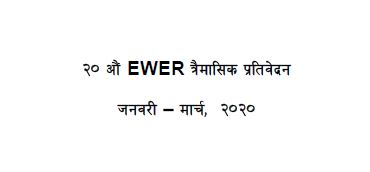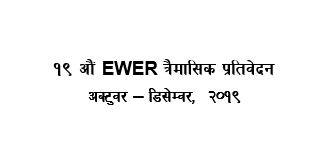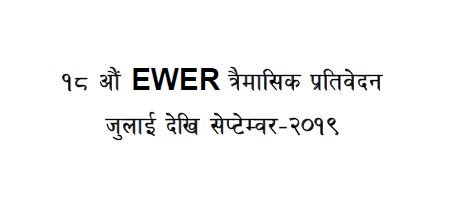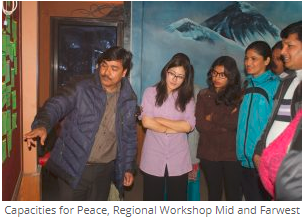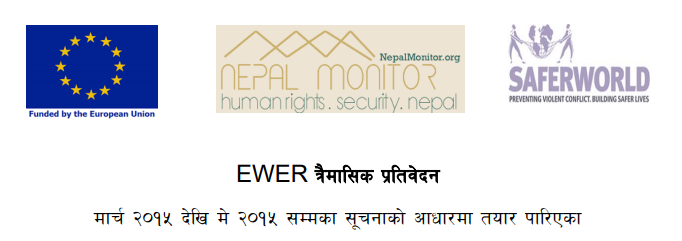Incident Reports
CIEDP extends complaints deadline
2016-06-13
The Commission of Investigation on Enforced Disappeared Persons has received 2,084 disappearance-related complaints, which is 589 more than the government’s official data.
Ministry of Peace and Reconstruction had listed 1,495 cases of enforced disappearance during the decade-long Maoist war that ended in November 2006.
CIEDP spokesperson Prof Bishnu Pathak told The Himalayan Times that the transitional mechanism extended the deadline till mid-July for lodging complaints of enforced disappearance.
Pathak expected the number of such complaints to exceed 2,500. CIEDP sources said those coming forward for the first time to lodge complaints had not got any relief money from the government yet.
When asked about the reason behind the surpassing of official data on enforced disappearance, Pathak said victims’ families who were poor and did not have access to political parties, human rights organisations or government bodies were not able to lodge complaints in the past.
“Those who could not come forward to lodge complaints for various reasons, including due to real and perceived threats, they now feel confident, as the transitional mechanism can protect their identity and help them get justice,” Pathak argued.
He, however, said the number of complaints was more than the official data, as the local peace committees had refused to list ‘missing persons’ as enforced disappearances.
Pathak said the CIEDP could again extend the deadline for filing complaints if the victims’ families so wanted.
When asked about the possibility of wrong people lodging complaints at CIEDP, Pathak said the transitional mechanism had developed enough checks in its system that could easily detect wrong complaints.
Pathak said the CIEDP was in favour of giving enough time to people of Upper Himalayan region, who were away from their homes picking Yarshagumba, to lodge complaints, if any.
The CIEDP has prepared 20-page forms to collect ante-mortem data within one and a half months to help the transitional body identify the victims when it exhumes bodies at suspected sites.
According to Pathak, the CIEDP will try to identify victims with the help of information contained in the ante-mortem forms and if it fails to do so, it will try to do so with the help of DNA data.
Pathak said the CIEDP was also planning to send psycho social counsellors with its staff who would visit victims’ families to collect ante-mortem data.
“Collecting ante-mortem data is a kind of reminding the victims of their tragedy and therefore we are sending psycho-social counsellors to console the victims’ families,” he added.
A CIEDP source said only 10 per cent complaints were against the Maoist cadres and the rest were against the erstwhile officials of security agencies, former prime ministers and former home ministers and former chief of the CIAA.
The CIEDP has been receiving complaints on disappearance cases since April 14, and will continue to do so until mid-June.
बेपत्ता पारिएका व्यक्तिको छानबिन आयोगले सशस्त्र द्वन्द्वका बेला बेपत्ता पारिएका व्याक्तिहरूको छानबिनका लागि जेठ मसान्तसम्म तोकेको उजुरी सङ्कलनको समयावधि एक महिनाका लागि थप गरेको छ । आयोगले गरेको यो निर्णयसँगै बेपत्ता पारिएका व्यक्तिको छानबीनका लागि असार मसान्तसम्मका लागि उजुरी गर्नसक्ने गरी अवधि थप भएको छ ।
पीडित र सरोकारवाला निकायहरूको माग बमोजिम उजुरी सङ्कलनको अवधि थप गरिएको आयोगका प्रवक्ता डा. विष्णु पाठकले जानकारी दिए । प्रवक्ता पाठकले उजुरीको समयावधि आवश्यकता अनुसार थपिँदै जानसक्ने तर्फ सङ्केत गर्दै आयोगको कार्यकाल सकिनु ६ महिना अघिसम्म पनि उजुरी लिइने जानकारी दिए ।
प्रवक्ता पाठकका अनुसार आयोगमा अहिलेसम्म २ हजार ८४ ओटा उजुरी परेको छ । यस अघि शान्ति तथा पुनःनिर्माण मन्त्रालयमा १ हजार ४ सय ९५ जना बेपता पारिएको भन्ने उजुरी परेको थियो । तर, इन्सेकको अभिलेखमा भने ९ सय ३२ जनालाई बलपूर्वक बेपत्ता पारिएको उल्लेख छ । अभिलेख अनुसार पूर्वाञ्चलमा ९६ जना, मध्यमाञ्चलमा १ सय ८४ जना, पश्चिमाञ्चलमा १ सय ३२ जना, मध्यपश्चिमाञ्चलमा ४ सय ६८ जना र सुदूरपश्चिमाञ्चलमा ५२ जनालाई राज्य र तत्कालीन विद्रोही नेकपा माओवादी दुवै पक्षबाट बलपूर्वक बेपत्ता पारिएको उल्लेख छ ।
National/Online Media
Related Reports
Transitional Justice / Conflict Victims / Kathmandu
Demonstration staged demanding to rectify TRC bill
August 04, 2023
Transitional Justice / Conflict Victims / Kathmandu
Police detain protesting armed conflict survivors in Kathmandu
April 18, 2023
Transitional Justice / Conflict Victims / Kathmandu
Conflict victims, police clash at New Baneshwar
April 18, 2023
Transitional Justice / Conflict Victims / Kaski
Conflict victims stage sit-in in Kaski demanding to make transitional justice bill victim friendly
March 31, 2023
Transitional Justice / Conflict Victims / Kathmandu
Conflict victims stage demonstration in Kathmandu demanding honorable justice
August 15, 2022
